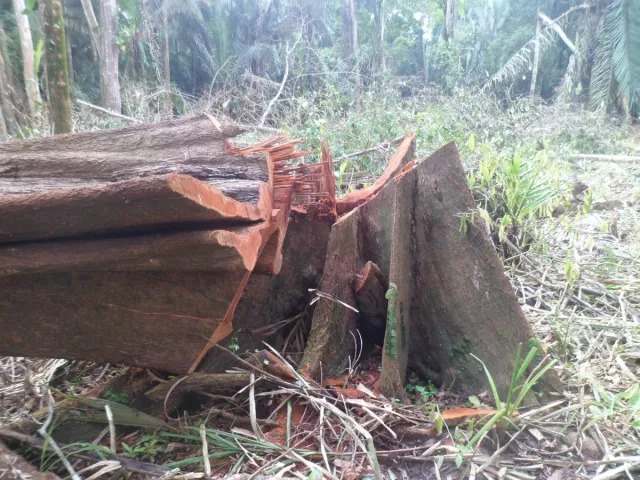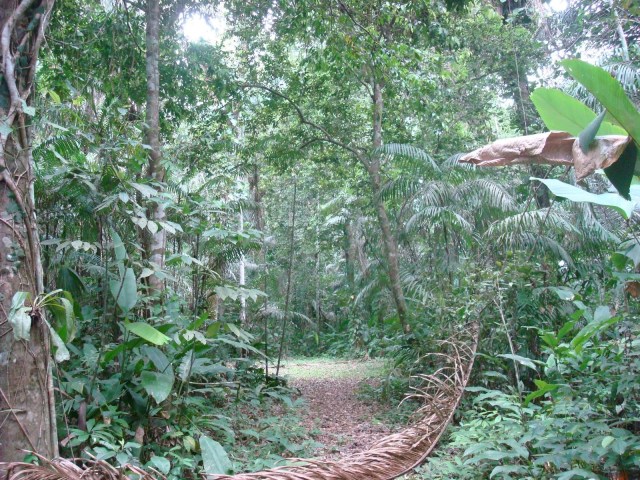
At a distant 722 kilometers from Caracas, capital of Venezuela, in the western part of the national territory, more specifically in the plains of the Barinas State, is the Caparo Forest Reserve. Its name allows us to imagine that it is a large forested area that benefits the population and that is a guarantee of living what could be the closest thing to a paradise, which it was, but that is no longer the case.
Walter Obregón / Correspondent lapatilla.com
In the last six years this natural habitat has suffered the excesses of a swarm of merchants and few mourners. Numerous groups of invaders, who take refuge under the colors of the revolution, who organized taking the name of God in vain and others who are included in the list of irregular armed groups, have destroyed at least 168,370 hectares (415,873.90 acres), of a total of 174,370 ha (430,860.27 ac), area decreed as protected back in 1961 when the Caparo Forest Reserve was established.
The change in use that the current occupants have given to this territory has had serious consequences. The exploited forest species did not achieve their renewal, the fauna has gone almost completely extinct, the logging agreements ceased to exist and the scientific surveillance and research, although diminished, refuse to die, as stated by the forestry engineer who graduated from the University of Los Andes (ULA), Carlos Castro.
To learn about what the Caparo Forest Reserve was and have a closer idea of what it is now, apart from the ULA engineer Carlos Castro, lapatilla.com also contacted José Rafael Lozada Dávila, another forestry engineer and teacher and researcher at the ULA Mérida campus, who participated in a large part of the research projects entrusted to the University of Los Andes in this area.
The ULA in the Caparo Forest Reserve

“The ULA has been present in Caparo since 1970, with many research projects and (forest) inventory work,” José Rafael Lozada Dávila began by saying, remembering that in those times, institutions like CorpoAndes were responsible for promoting the participation of the University in Merida to carry out the aforementioned initial inventory.
“After completing this inventory, several faculty professors saw the need to carry out various research projects,” commented Lozada Dávila, calculating that there have been almost 54 years of ULA presence in what remains of the Caparo Forest Reserve.
After 12 years of research activity, in 1982, the Ministry of the Environment decided to grant the ULA, through the Faculty of Forestry and Environmental Sciences, a “forestry research unit”, which is what to this day It is called Caparo Experimental Station, and that was done under the figure of “commodatum” over an area of 7,000 hectares.
“This is a contract between the Ministry of the Environment and the university, which establishes obligations regarding the protection and surveillance, research and development of other activities, which has been renewed, but the first ones that were granted had a duration of 15 and 20 years.”
The last contract between the ULA and the current Ministry of Ecosocialism was signed between 2022 and 2023, so the presence of the university in Caparo at this time is supported by this legal figure.
Research projects

The ULA’s motivation to go to Caparo was the challenge and interest of carrying out a forest inventory, but the specialists immediately realized the need to study the ecosystem in its entirety.
“It was necessary to study the soils, the dynamics of the soils, the processes of soil formation, the relationship between soils and vegetation, how it is possible that there are so many ecosystems in Caparo and there the answer was in the soil,” he explained. the engineer.
Likewise, it was necessary to study the dynamics of water in the soil, what the flooding processes are like, the sediment mobilization processes that “is what gives rise to the diversity of soils in Caparo,” said the specialist.
All this work was accompanied by botanical research, identifying the species, collecting botanical specimens to take them to herbaria, and as it was a forest reserve when in the 70s were starting the first plans for forest planning and management in Venezuela, so we had to do a lot of applied research, that is, we had to learn about how some species of timber interest respond to different forms of plantation and different forms of soil.”
From this investigative process was determined many culturing techniques, for example, “about the ‘saqui saqui’, how it responds in shoals, banks, sub-banks, and also different forms of plantation, whether it is in a ball of soil, in bare root or cut stump.”
Lozada Dávila assured that these studies were carried out for many native and exotic species, including Teak and Melina, but since they were first stage experiments, some of the results were not appropriate because some of these the plants did not respond well, although “in Science it is said that a negative result is a result.”
With this, the scientists were able to determine for the future of successful plantations that “Teak in shallows, in floodplains, does not give good results, and that is interesting and important because then it was necessary to direct where Teak could be planted.”
“Later it was determined that on a trimmed stump Teak gives very good results, so that reduces planting costs, and so on.”
In summary, the forestry engineer appreciated that through the Caparo Experimental Station, the ULA carried out ecological, botanical and other research applied to forestry, plantation and silviculture techniques (science aimed at the formation and cultivation of forests), considering its immense natural wealth.
About the research projects
Engineer Lozada Dávila does not know the exact number of projects that could have been started over this time in the Caparo Forest Reserve, but he is sure that “there were many, some individual projects that were being developed by the pioneer professors of Caparo and group projects,” and these results were sometimes transferred to all members of the reserve, guaranteeing their participation and execution.
As explained by the forestry specialist, the Caparo reserve was considered and began to be cared for as a space that projected progress and advancement in the study of natural species, and a source of natural riches that were vandalized.
In relation to the research projects that were completed, at this moment there is no total in the hands of engineer Lozada Dávila, but he assured that before the debacle caused by the entry of the invaders to the Caparo Forest Reserve, there were many that managed to reach their final phase.
Up to 2018, Lozada Dávila was able to prepare an archive of all the articles and research documents that have been published as a result of the university’s activity in the Caparo Forest Reserve.
“There are hundreds of scientific documents that have been published. There is everything, from theses by forestry experts, senior forestry technicians, forestry engineers, master’s theses and doctoral theses, from institutions in Venezuela and abroad,” he assured.
Professionals from Europe have come to Caparo in order to do their doctorate research and “many of us have also done doctoral theses using data from Caparo,” he highlighted.
“In the last two or three years, perhaps scientific productivity has decreased a lot due to the problems we have in the country, but surely there must be some other articles out there.”
Promotion of the invasion
Until 1999, Caparo had a very good forest cover that exceeded 80% of the entire forest reserve, and although there were already a few farmers who had invaded some areas, and deforested them to make way for livestock and agriculture, the damage was still small and not felt overall in the reserve.
“Starting in 2000, in my opinion, as a result to some decisions of the Government, there was a massive process of invasion and occupation of the forest reserve, which was not only in Caparo, it also happened in Ticoporo, San Camilo and, in general, in the western plains and north of the Orinoco river,” he recalled.
Currently, there are very few lowland forests left in the northern Orinoco basin, as a consequence of those decisions of the Government of former President Hugo Chávez who took office in 1999.
“The presence of the ULA in Caparo is the factor that has allowed us to maintain this vestige of forest that today is barely about 6,000 hectares of forest,” Lozada Dávila calculated, considering that for him “it is the last ecologically viable extant forest of what was the ecosystem of the western plains of Venezuela”.
“There we even had jaguars, at least until 2018, where there were also pumas, tapirs, limpets, foxes, various kinds of monkeys, many birds typical of the western plains, and when we say perfectly viable, it is because in those 6,000 hectares those species of fauna could still coexist and survive.”
The forestry engineer referred to other small remnants in the western plains, which are about 500 hectares or even 1,000 hectares, but in these spaces “a jaguar or a tapir cannot live.”
What Caparo is trying to save
Engineer José Rafael Lozada Dávila remembers that it was in January 2018, when a large invasion of about 300 families, who he presumes are responsible for the disappearance of tapirs, báquiros (pecaris), tigers (jaguars), even the American mountain lion. which was also present in this forest reserve.
“I have no information that any jaguars or their footprints have been seen since 2018,” he added.
The threats have continued in the Caparo Forest Reserve, or what remains of it, but in general the Experimental Station of the University of Los Andes remains in this territory, because in its opinion “in the event that the ULA leaves Caparo”, would mean the definitive loss of this unique ecosystem and of a long tradition of research that has been on recently been interrupted, due to the deplorable budgetary state of universities.”
The ULA as institution is still in what they insist on calling the “Caparo Forest Reserve”, protected by an agreement, with its research station that is very deteriorated, with its workers earning very low salaries, which also becomes a threat, but its permanence becomes a great act of resistance to letting it die completely.

